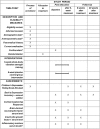Effects of a 6-week, whole-body vibration strength-training on depression symptoms, endocrinological and neurobiological parameters in adolescent inpatients experiencing a major depressive episode (the "Balancing Vibrations Study"): study protocol for a randomized placebo-controlled trial
- PMID: 29970142
- PMCID: PMC6029053
- DOI: 10.1186/s13063-018-2747-8
Effects of a 6-week, whole-body vibration strength-training on depression symptoms, endocrinological and neurobiological parameters in adolescent inpatients experiencing a major depressive episode (the "Balancing Vibrations Study"): study protocol for a randomized placebo-controlled trial
Abstract
Background: Moderate to vigorous endurance and strength-training exercise was suggested as a treatment option for major depression. However, there is little evidence to support this suggestion in adolescent patients. The present study investigates the effects of a whole-body vibration strength-training intervention on symptoms in medication-naïve adolescent inpatients experiencing a major depressive episode. Potential underlying endocrinological and neurobiological mechanisms are explored.
Methods/design: A double-blinded randomized controlled trial is conducted at the University Hospital of Cologne in Germany, comparing a 6-week, whole-body vibration strength-training with a 6-week placebo-intervention, as add-on therapy to inpatient treatment as usual. Forty-one subjects (13-18 years of age) will be included in each of the two groups. The study is powered to detect (α = .05, β = .2) a medium effect size difference between the two groups (d = .5) in terms of patients' change in the Children's Depression Rating Scale raw-score, from baseline until the end of the intervention. As secondary endpoints, the effects of exercise treatment on patients' cortisol awakening response as well as on brain-derived neurotrophic factor, insulin-like growth factor 1 and inflammatory markers (tumor necrosis factor-alpha, interleukin-6 and C-reactive protein) serum levels will be assessed.
Discussion: This study will provide evidence on the effectiveness of whole-body vibration strength-training as an add-on therapy in adolescent inpatients experiencing a major depressive episode. After completion of data collection, the present study will be the largest randomized controlled trial so far to investigate the effectiveness of an exercise intervention in inpatient adolescents suffering from a major depressive episode. Moreover, the present study may help to determine the underlying mechanisms of potential anti-depressant effects of exercise in depressed adolescent inpatients.
Trial registration: DRKS.de, German Clinical Trials Register (DRKS), Identifier: DRKS00011772 . Registered on 20 March 2017.
Keywords: Adolescence; Cortisol; Exercise; Inflammatory markers; Major depression; Neurotrophins; Whole-body vibration.
Conflict of interest statement
Ethics approval and consent to participate
Ethical approval has been obtained from the Ethics Committee of the University Hospital of Cologne, Germany (reference number 15–426). The trial was registered at drks.de (ID: DRKS00011772) prior to starting recruitment. Patients are being informed about the risks and possible benefits of the study. Participation in this study is voluntary. Written informed consent is being obtained from all patients.
Consent for publication
All participants give consent to the publication of the results and receive adequate anonymization. All data will be analyzed with confidentiality. This information is included in the written informed consent.
Competing interests
The authors declare that they have no competing interests.
Publisher’s Note
Springer Nature remains neutral with regard to jurisdictional claims in published maps and institutional affiliations.
Figures


References
Publication types
MeSH terms
Substances
Grants and funding
LinkOut - more resources
Full Text Sources
Other Literature Sources
Medical
Research Materials
Miscellaneous

